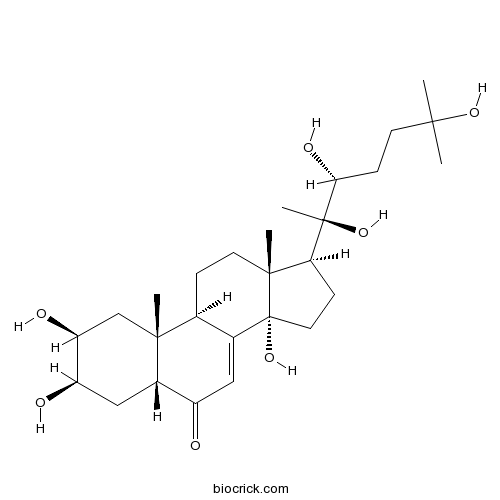Asparagus filicinus
Asparagus filicinus
1. The products in our compound library are selected from thousands of unique natural products; 2. It has the characteristics of diverse structure, diverse sources and wide coverage of activities; 3. Provide information on the activity of products from major journals, patents and research reports around the world, providing theoretical direction and research basis for further research and screening; 4. Free combination according to the type, source, target and disease of natural product; 5. The compound powder is placed in a covered tube and then discharged into a 10 x 10 cryostat; 6. Transport in ice pack or dry ice pack. Please store it at -20 °C as soon as possible after receiving the product, and use it as soon as possible after opening.
Natural products/compounds from Asparagus filicinus
- Cat.No. Product Name CAS Number COA
-
BCN5688
20-Hydroxyecdysone5289-74-7
Instructions

Innovative Approach to the Accumulation of Rubrosterone by Fermentation of Asparagus filicinus with Fusarium oxysporum.[Pubmed: 26145461]
Rubrosterone, possessing various remarkable bioactivities, is an insect-molting C19-steroid. However, only very small amounts are available for biological tests due to its limited content from plant sources. Fungi of genus Fusarium have been reported to have the ability to convert C27-steroids into C19-steroids. In this study, Asparagus filicinus, containing a high content of 20-hydroxyecdysone, was utilized to accumulate rubrosterone through solid fermentation by Fusarium oxysporum. The results showed that F. oxysporum had the ability to facilitate the complete biotransformation of 20-hydroxyecdysone to rubrosterone by solid-state fermentation. The present method could be an innovative and efficient approach to accumulate rubrosterone with an outstanding conversion ratio.
Aspafilioside B induces G2/M cell cycle arrest and apoptosis by up-regulating H-Ras and N-Ras via ERK and p38 MAPK signaling pathways in human hepatoma HepG2 cells.[Pubmed: 25683703]
We recently establish that aspafilioside B, a steroidal saponin extracted from Asparagus filicinus, is an active cytotoxic component. However, its antitumor activity is till unknown. In this study, the anticancer effect of aspafilioside B against HCC cells and the underlying mechanisms were investigated. Our results showed that aspafilioside B inhibited the growth and proliferation of HCC cell lines. Further study revealed that aspafilioside B could significantly induce G2 phase cell cycle arrest and apoptosis, accompanying the accumulation of reactive oxygen species (ROS), but blocking ROS generation with N-acetyl-l-cysteine (NAC) could not prevent G2/M arrest and apoptosis. Additionally, treatment with aspafilioside B induced phosphorylation of extracellular signal-regulated kinase (ERK) and p38 MAP kinase. Moreover, both ERK inhibitor PD98059 and p38 inhibitor SB203580 almost abolished the G2/M phase arrest and apoptosis induced by aspafilioside B, and reversed the expression of cell cycle- and apoptosis-related proteins. We also found that aspafilioside B treatment increased both Ras and Raf activation, and transfection of cells with H-Ras and N-Ras shRNA almost attenuated aspafilioside B-induced G2 phase arrest and apoptosis as well as the ERK and p38 activation. Finally, in vivo, aspafilioside B suppressed tumor growth in mouse xenograft models, and the mechanism was the same as in vitro study. Collectively, these findings indicated that aspafilioside B may up-regulate H-Ras and N-Ras, causing c-Raf phosphorylation, and lead to ERK and p38 activation, which consequently induced the G2 phase arrest and apoptosis. This study provides the evidence that aspafilioside B is a promising therapeutic agent against HCC.
Steroidal saponins and ecdysterone from Asparagus filicinus and their cytotoxic activities.[Pubmed: 20470812]
Two new spirostanoides, filiasparosides E (1) and F (2), one new furostanoside, filiasparoside G (3), and one new ecdysterone, stachysterone A-20, 22-acetonide (4), together with six known steroidal saponins, asparagusin A (5), filiasparoside A (6), filiasparoside B (7), aspafilioside A (8), aspafilioside B (9), and filiasparoside C (10) were isolated from the roots of Asparagus filicinus Buch.-Ham. Their structures were elucidated on the basis of spectroscopic and chemical evidence. Compounds 1-10 were investigated for their cytotoxicities against human breast adenocarcinoma MDA-MB-231 cell line and compounds 8-10 exhibited cytotoxic activities with IC(50) values ranging from 3.4 to 6.6microM.
Antiviral activity of some plants used in Nepalese traditional medicine.[Pubmed: 18955262]
Methanolic extracts of 41 plant species belonging to 27 families used in the traditional medicine in Nepal have been investigated for in vitro antiviral activity against Herpes simplex virus type 1 (HSV-1) and influenza virus A by dye uptake assay in the systems HSV-1/Vero cells and influenza virus A/MDCK cells. The extracts of Astilbe rivularis, Bergenia ciliata, Cassiope fastigiata and Thymus linearis showed potent anti-herpes viral activity. The extracts of Allium oreoprasum, Androsace strigilosa, Asparagus filicinus, Astilbe rivularis, Bergenia ciliata and Verbascum thapsus exhibited strong anti-influenza viral activity. Only the extracts of A. rivularis and B. ciliata demonstrated remarkable activity against both viruses.
Steroidal saponins from the roots of Asparagus filicinus.[Pubmed: 17953975]
Two new steroidal saponins with a new aglycone moiety, aspafiliosides E (1) and F (2), were isolated from the roots of Asparagus filicinus Buch.-Ham. Their structures were fully elucidated on the basis of detailed spectroscopic study and chemical analysis.
Filiasparosides A-D, cytotoxic steroidal saponins from the roots of Asparagus filicinus.[Pubmed: 17629328]
Four new steroidal saponins, filiasparosides A-D (1-4), together with known aspafiliosides A (5) and B (6) were isolated from the roots of Asparagus filicinus. The structures of these new compounds were elucidated by detailed spectroscopic study and chemical analysis. Compounds 1-6 were cytotoxic against human lung carcinoma (A549) and breast adenocarcinoma (MCF-7) tumor cell lines with EC(50) values of 2.3-16.8 microg/mL. Compound 3 showed the most potent cytotoxicity, with EC(50) values of 2.3 and 3.0 microg/mL toward A549 and MCF-7 cell lines, respectively.
Furostanoside from Asparagus filicinus.[Pubmed: 15621601]
A new furostanoside, named aspafilioside D (1), together with the five known compounds officinalisnin-II (2), Asp-IV' (3), (+)-4'-O-methyl-nyasol (4), (+)-nyasol (5) and tormentic acid (6), have been isolated from the roots of Asparagus filicinus. The structure of 1 has been elucidated on the basis of spectral data.
Oligofurostanosides and oligospirostanosides from roots of Asparagus filicinus.[Pubmed: 8821436]
The ethanolic extract roots of Asparagus filicinus contains a complex mixture of steroidal saponins, from which two oligospirostanosides (Filicinins A and B) and two oligofurostanosides (Filicinosides C and D) were characterized.


